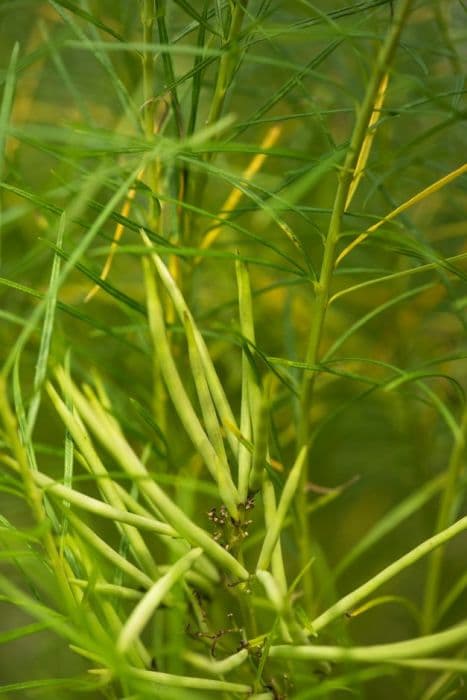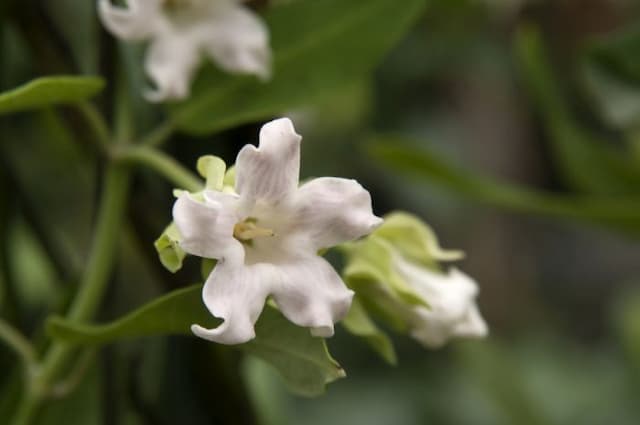Star Jasmine Trachelospermum jasminoides 'Tricolor' (v)

ABOUT
The Tricolored Star Jasmine is a vibrant and lush climbing plant known for its striking foliage and beautiful flowers. Its leaves are a mix of green, pink, and creamy white, making it a standout for its variegated appearance. Each leaf typically shapes into an oval form with a glossy texture, adding a lively splash of color to any garden space. During the blossoming season, this plant produces clusters of star-shaped, sweet-scented flowers that start off as pink buds, eventually blooming into a pristine white. These fragrant blossoms are particularly appealing, not just for their beauty, but also for their ability to attract butterflies and other pollinators. The overall impression of the Tricolored Star Jasmine is one of an elegant and aromatic plant that can add visual appeal and fragrance to its surroundings.
About this plant
 Names
NamesFamily
Apocynaceae
Synonyms
Variegated Star Jasmine, Tricolor Star Jasmine, Tricolour Jasmine, Variegated Confederate Jasmine, Variegated Chinese Jasmine
Common names
Rhynchospermum jasminoides, Rhynchospermum jasminoides var. tricolor, Trachelospermum jasminoides 'Variegatum'.
 Toxicity
ToxicityTo humans
Star jasmine, specifically the Trachelospermum jasminoides 'Tricolor', has low toxicity to humans. While it is not typically considered dangerously poisonous, ingestion of parts of the plant may cause minor symptoms such as nausea, vomiting, and diarrhea. Generally, these symptoms are self-limiting and do not lead to severe consequences, but if large quantities are ingested or if symptoms persist, medical attention should be sought.
To pets
To pets, star jasmine can pose a toxicity risk. Ingesting parts of the plant, especially in significant amounts, can cause symptoms like vomiting, diarrhea, and depression in animals such as cats and dogs. If you suspect your pet has ingested star jasmine, it is important to consult with a veterinarian to ensure appropriate care and treatment.
 Characteristics
CharacteristicsLife cycle
Perennials
Foliage type
Evergreen
Color of leaves
Variegated
Flower color
White
Height
4-6 feet (1.2-1.8 meters)
Spread
4-6 feet (1.2-1.8 meters)
Plant type
Climber
Hardiness zones
8-10
Native area
Asia
Benefits
 General Benefits
General Benefits- Aesthetic Appeal: The variegated leaves of Trachelospermum jasminoides 'Tricolor' add a splash of color and visual interest to gardens and landscapes.
- Fragrant Flowers: This plant produces highly fragrant, star-shaped flowers that can add a pleasant scent to the surrounding area.
- Versatility: It can be used in a variety of garden settings including as ground cover, climbing walls, or trellises, adapting to both full sun and partial shade.
- Low Maintenance: Once established, it requires minimal care beyond occasional watering and pruning to maintain its shape and health.
- Long Blooming Period: The star jasmine typically enjoys a long flowering season, providing color and fragrance for an extended period.
- Habitat for Wildlife: The flowers attract pollinators such as bees and butterflies, enhancing biodiversity in the garden.
- Privacy Screen: When trained on a fence or trellis, it can provide a dense screen for privacy or to hide unsightly areas.
 Medical Properties
Medical PropertiesThis plant is not used for medical purposes.
 Air-purifying Qualities
Air-purifying QualitiesThis plant is not specifically known for air purifying qualities.
 Other Uses
Other Uses- Star jasmine 'Tricolor' can be used as a natural pest repellent in gardens, due to its strong scent which is not favored by many insects and animal pests.
- The plant can be grown as a ground cover in areas where grass might struggle to grow, such as under trees with heavy shade.
- It can be used for topiary or shaping into form in themed gardens due to its flexible stems and willingness to be trained.
- As an educational tool in botany or horticulture classes, star jasmine 'Tricolor' can demonstrate plant variegation and the survival of plants with less chlorophyll.
- It may be utilized as a natural dye, where the flowers or leaves can provide shades of green or yellow depending on the mordant used.
- The plant’s dried vines can be used for weaving small, scented decorative items like wreaths, imparting a subtle fragrance to a room.
- Star jasmine 'Tricolor' is useful for creating living curtains along a balcony or patio, offering privacy and aesthetic appeal.
- The thick foliage can provide a habitat for beneficial insects such as bees and butterflies, supporting local biodiversity.
- Used in sensory gardens, the plant’s textured leaves and fragrant flowers provide a multi-sensory experience.
- Its leaves can serve as a green mulch, which will decompose and enrich the soil with essential nutrients.
Interesting Facts
 Feng Shui
Feng ShuiStar Jasmine, which is the common name for Trachelospermum jasminoides 'Tricolor', is not specifically mentioned in traditional Feng Shui practice. However, in general, plants with lush foliage and pleasant scents like Star Jasmine are considered to enhance the Wood element and can be used to bring positive energy, promote well-being, and create a calming atmosphere in the home.
 Zodiac Sign Compitability
Zodiac Sign CompitabilityStar Jasmine is not used in astrology practice.
 Plant Symbolism
Plant Symbolism- Love & Affection: Trachelospermum jasminoides 'Tricolor', commonly known as Star Jasmine, is often associated with love and affection due to its sweet fragrance and delicate white blooms, reminiscent of purity and simplicity in relationships.
- Sensual Charm: The plant's intoxicating scent is also seen as a symbol of sensuality and allure, drawing parallels with its ability to captivate through the senses.
- Purity: The pristine white flowers of Star Jasmine are often linked with purity and innocence, echoing traditional meanings assigned to the color white in floral symbolism.
- Good Luck: Some cultures believe that the Star Jasmine brings good luck, especially when planted near dwellings, as its evergreen nature signifies endurance and perseverance.
- Peace & Tranquility: Due to the calming effect of its fragrance, Star Jasmine is sometimes associated with peace and tranquility, offering a sense of soothing serenity to those in its presence.
 Water
WaterThe Star Jasmine 'Tricolor' should be watered thoroughly, ensuring the soil is moist but not waterlogged. During the growing season, water when the top inch of soil feels dry, which may be once a week, depending on climate conditions. Decrease watering in the winter to every two weeks, or as needed if the plant is indoors and the air is dry. Provide about one to two gallons of water per plant each time you water, ensuring even distribution around the root zone. Overhead watering is not recommended to prevent foliar diseases; instead, water at the base of the plant.
 Light
LightStar Jasmine 'Tricolor' thrives best in full sun to partial shade conditions. The ideal spot is where the plant will receive at least four to six hours of direct sunlight a day, but it also tolerates shaded areas where it gets bright, indirect light. Avoid placing it in deep shade as it may inhibit growth and flowering.
 Temperature
TemperatureStar Jasmine 'Tricolor' prefers a temperate climate and can tolerate a range between 60°F to 80°F for ideal growth. It can survive minimum temperatures down to about 10°F but should be protected from prolonged exposure to freezing conditions. To ensure robust growth, try to maintain a temperature close to the higher end of its preferred range during the day and slightly cooler at night.
 Pruning
PruningPruning Star Jasmine 'Tricolor' helps maintain its shape, encourage bushier growth, and remove any dead or damaged foliage. It is best to prune in late winter or early spring before new growth begins. Prune as needed throughout the year to keep the plant tidy. Do not over-prune, as this can reduce flowering; just remove the necessary parts to shape the vine or control its size.
 Cleaning
CleaningAs needed
 Soil
SoilStar Jasmine 'Tricolor' thrives in well-draining, loamy soil with a pH of 6.0 to 7.5. A mix of two parts peat moss, one part perlite, and one part pine bark suits it well for nutrients and drainage.
 Repotting
RepottingStar Jasmine 'Tricolor' should be repotted every 2-3 years, or when it becomes root-bound, to ensure healthy growth and sufficient room for root development.
 Humidity & Misting
Humidity & MistingStar Jasmine 'Tricolor' prefers moderate to high humidity levels, around 50-70%, but it is quite adaptable and can tolerate lower humidity when necessary.
 Suitable locations
Suitable locationsIndoor
Place in bright, indirect light, and maintain moderate humidity.
Outdoor
Grow in sun to partial shade, shelter from harsh conditions.
Hardiness zone
8-10 USDA
 Life cycle
Life cycleStar Jasmine 'Tricolor' begins its life as a seed, germinating in warm soil conditions, with adequate moisture. Upon sprouting, the seedling develops into a young plant with distinctive variegated foliage, showcasing green, white, and pink leaves. As it matures, the vine develops woody stems and climbs or spreads, depending on the support provided. During the growing seasons, usually in late spring to early summer, it produces clusters of fragrant, white flowers which attract pollinators. After pollination, small seed pods may form, containing seeds for the next generation. Over the years, with proper care, the evergreen plant can become a dense and lush groundcover or climbing vine, providing year-round interest.
 Propogation
PropogationPropogation time
Spring to Summer
The most popular method for propagating the Tricolor Star Jasmine is through semi-hardwood cuttings. This process typically begins during the summer months when growth is active but the stems have started to firm up. To propagate, a gardener would cut a 4 to 6-inch (10 to 15 cm) stem section with several leaves attached, making sure to snip just below a node where leaf joints meet the stem. The lower leaves are usually removed, and the cut end may be dipped in a rooting hormone powder to encourage root development. This prepared cutting is then inserted into a well-draining potting mix, ensuring at least one node is buried where roots can form. To maintain high humidity levels, which are instrumental for root growth, the pot can be loosely covered with a plastic bag or placed in a propagator. With consistent moisture and warmth, roots typically develop in a few weeks, after which the new plant can be gradually acclimatized to less protected conditions before transplanting.









